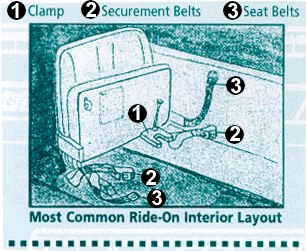Ride On Bus Accessibility
A Commitment to the Americans with Disabilities Act
Ride On bus service is central to Montgomery County's commitment to provide accessible transportation for all its residents. The service allows passengers to take public transit to go to work and travel around the County. Ride On may be used by patrons who use a wheelchair, walker, or who otherwise need the assistance of a lift to board a Ride On bus. Today ALL (100%) of our fixed-route buses are low floor buses with ramps instead of lifts and are equipped with automated bus stop announcement systems that make stop announcements that can be heard by people who are blind or low vision and can be seen by those who are deaf or hard of hearing.
If you use a wheelchair or scooter, before you ride, measure side to side!
When the bus arrives at your bus stop, the operator will lower the ramp so that you can board. If you use a mobility device, it must fit on the ramp. Ramps on most of the Ride On buses are 28.5 inches wide and will safely support a maximum of 600 pounds. If you have any questions, you should check with the manufacturer of your device that it complies with the above specifications. (Next is a picture of the bus interior and wheelchair or mobility device securement area.)

The width of the aisle between the farebox and the stanchion pole is about 35 inches. On most of the Ride On buses, the wheelchair positions are located in the first set of forward facing seats on both sides of the bus. The seats fold up to reveal the securement devices. The side facing seats in front of the forward facing seats also fold up to provide more space for maneuvering. The area providing the most room to maneuver is located on the left side as you face the front of the bus (the driver's side of the bus).
Play It Safe!
All Ride On buses are equipped with securement devices. You are not required to use the securement devices or seat belts but if you would like to do so your bus operator is available to assist you. Your safety is the utmost importance to us, but it is up to you to fully understand the design of our bus and to determine whether your particular mobility device can maneuver on board, and be secured in one of the two positions. If you have a question as to whether or not your mobility device will fit on the lift, maneuver about the bus, and be secured safely, please call 311 with questions. Ride On buses have two securement positions for mobility devices. Each position is equipped with a rear wheel clamp, and one retractable securement belt on each side of the position. Each position is also equipped with a regular seatbelt. (Next is a picture of the securement area with the seat flipped up.)

All mobility devices can be secured by the rear wheel clamp on one side and the securement belt on the opposite side of the mobility device. If the rear wheels on your mobility device cannot be secured by the rear wheel clamp, the securement belts on both sides should be used. The securement belts should be secured onto a main structural member (frame) of the mobility device at approximately a 45 degree angle. Belts are mounted about 6 inches from the floor of the bus. We have tried to design the securement system so a large percentage of our patrons could operate it themselves. Our bus operators are available to assist in securing your mobility device.
Catching the Bus and Making Your Trip
Montgomery County is one of the nation's leaders in accessible bus stops. Our program is a model for the rest of the country. Eighty-five percent (85%) of our 5,441 bus stops are accessible, with plans underway to complete the remaining stops.
Passengers must board and alight only at designated Ride On bus stops. You should take it upon yourself to ensure that the stops at the beginning and end of your trip and at any transfer points are accessible. On the day of your trip you need to be at the bus stop several minutes before the bus is scheduled to arrive. The bus is on a regular schedule and cannot wait for any late arrival. If you miss the bus, another one will come according to the published schedule.
Special Identification Cards
Special identification cards for persons with disabilities are issued by the Washington Metropolitan Area Transit Authority (WMATA). To apply for this card, call WMATA at 202-962-2700. This card is accepted on all Ride On buses.
Please note that people who are unable to use the fixed-route transportation due to disability are encouraged to apply for Metro Access services through WMATA: https://www.wmata.com/service/accessibility/metro-access/.